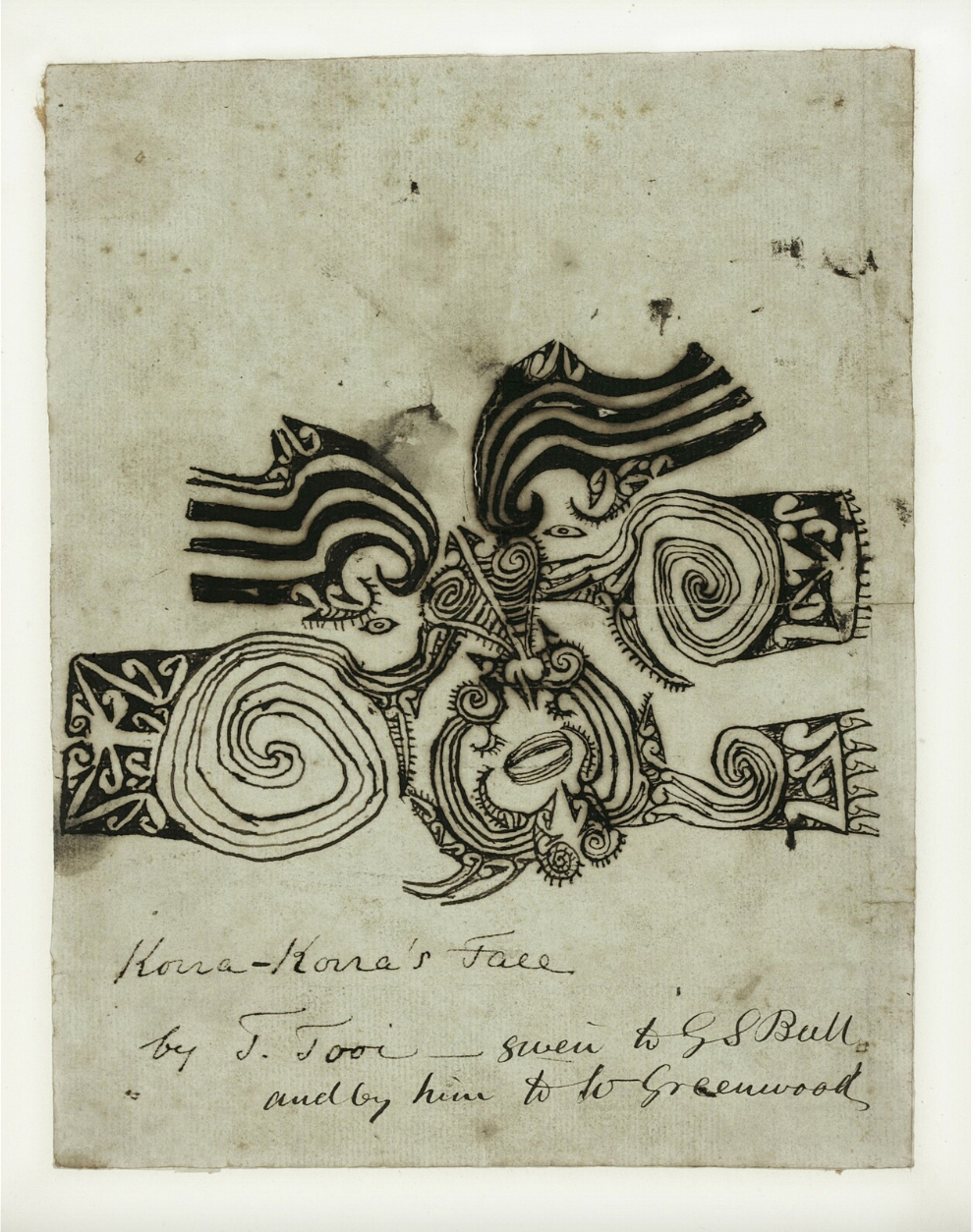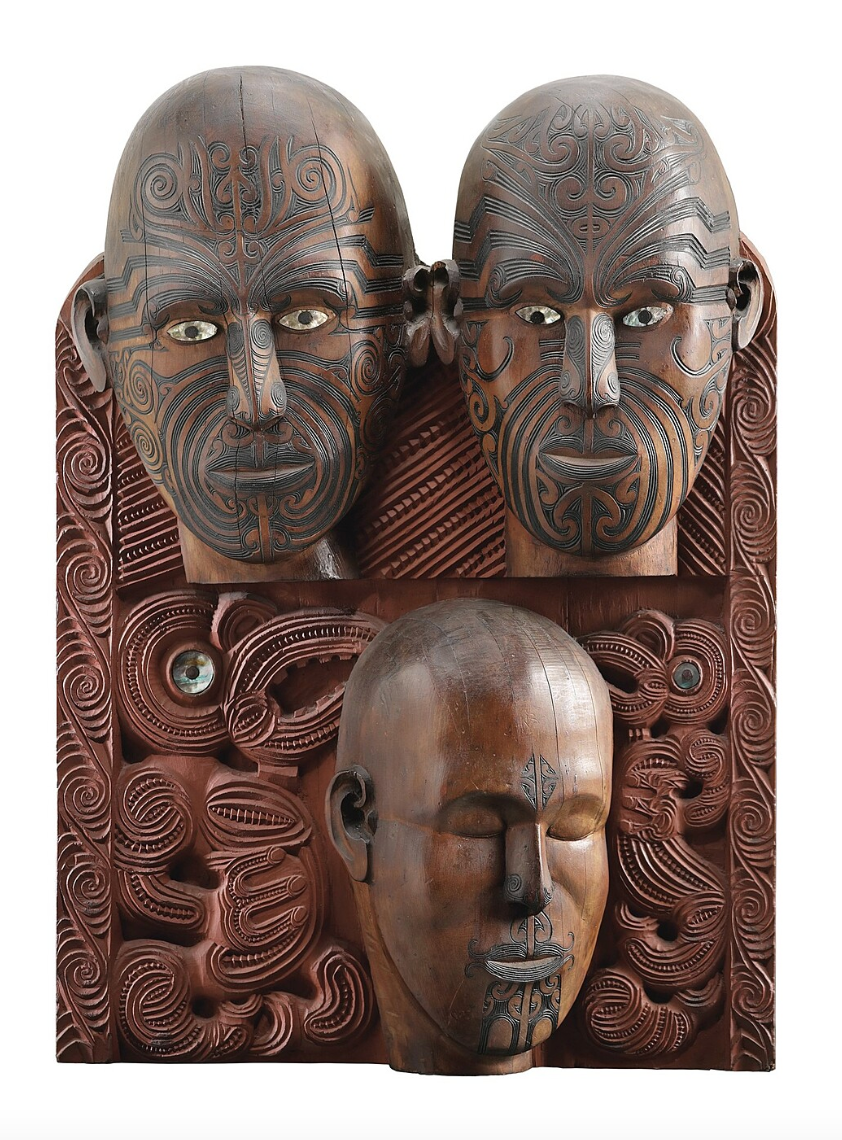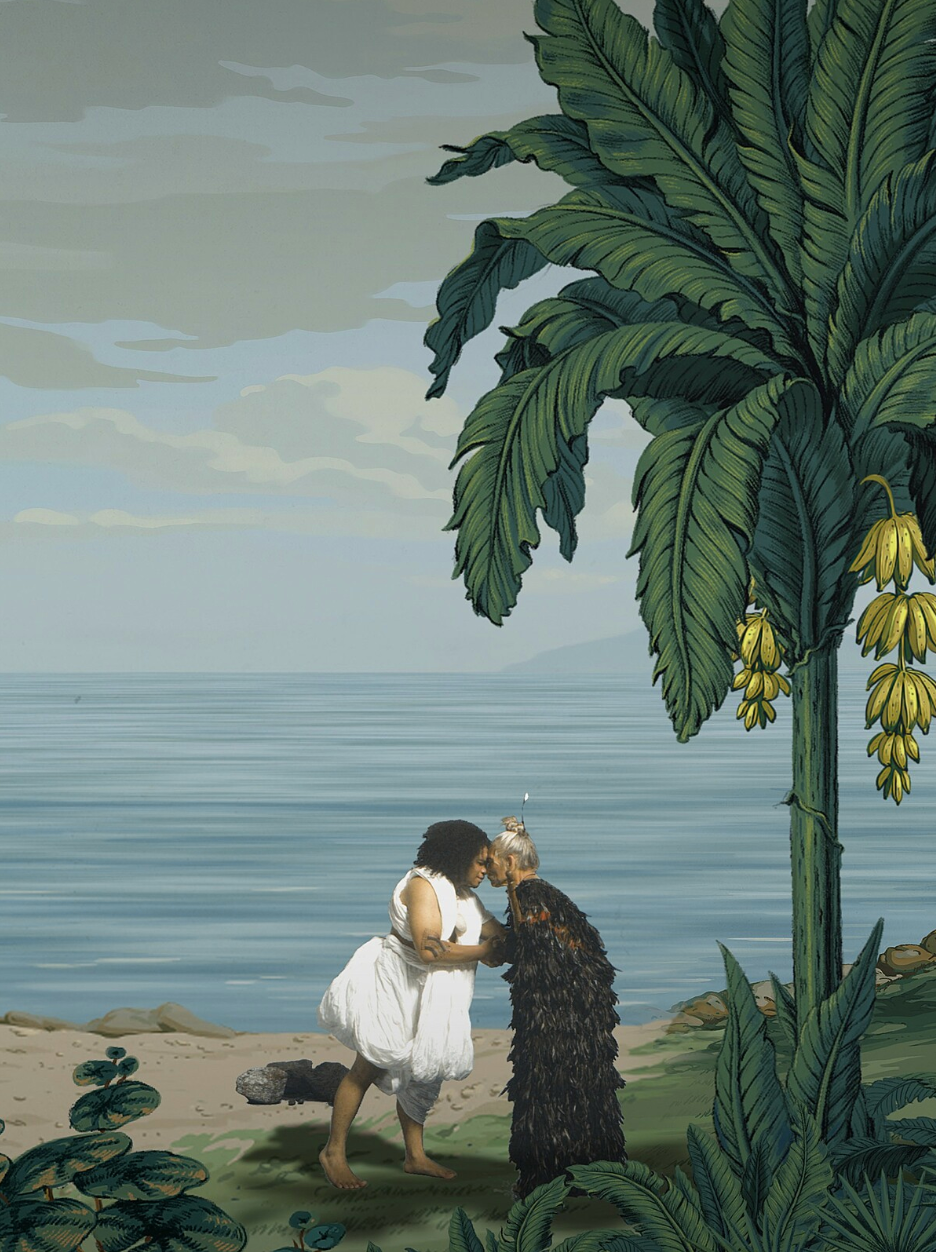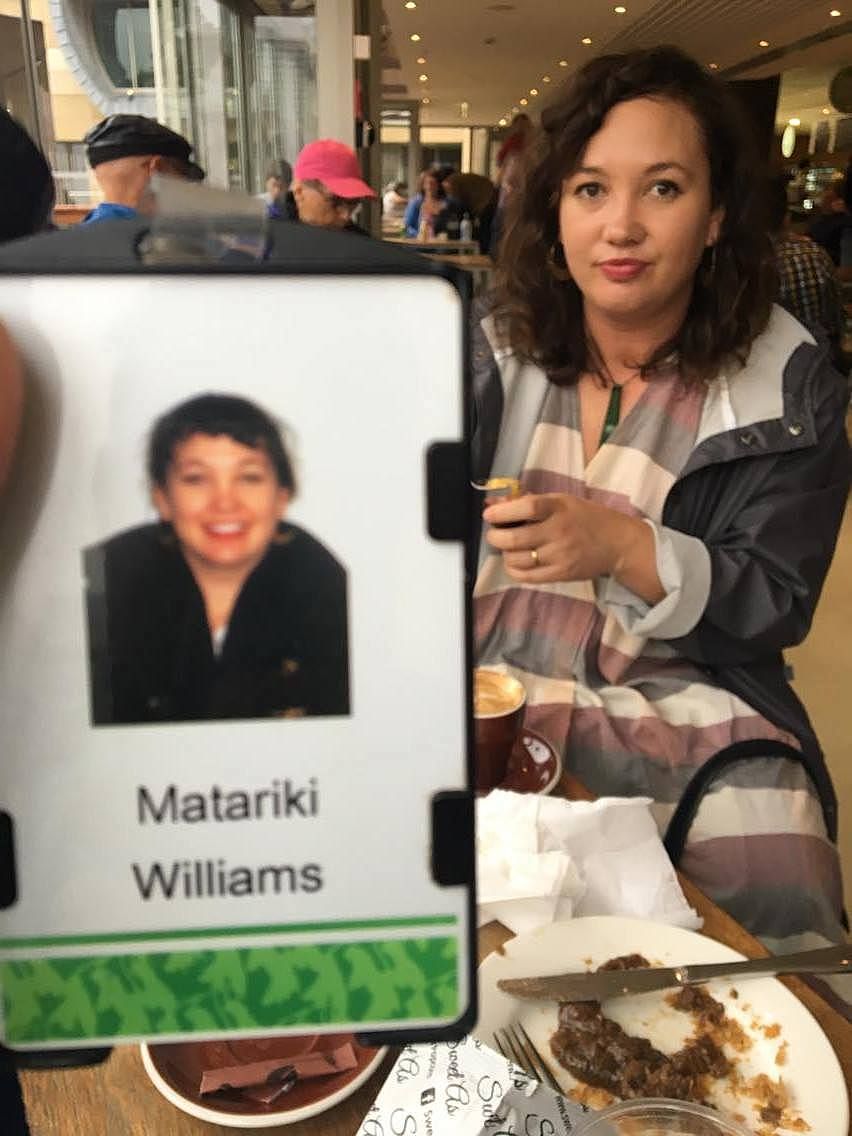Oceania As a Contact Zone, and the Myth of Museum Universalism
As the Oceania exhibition closes at the Royal Academy of Arts in London, Matariki Williams looks at its time there, and forward to its next site at the Musée du quai Branly - Jacques Chirac in Paris.
As the Oceania exhibition closes at the Royal Academy of Arts in London, Matariki Williams looks at its time there, and forward to its next site at the Musée du quai Branly – Jacques Chirac in Paris.
Across the seas, far inland, in a river, a white whale appeared. The appearance in the River Thames of the beluga, more commonly found in waters further north, coincided with the cultural blessings held for the opening of Oceania, an exhibition at the Royal Academy of Arts (RA) in London. Its presence was immediately taken as a tohu, a good one, for the future of the exhibition. I attended the opening of the exhibition and a number of events in its first week, all of which elicited multiple reactions. At times I was overcome by the privilege it was to view taonga that have been away from our whenua for decades, centuries. Other times, I was enraged at the injustice of what has happened to our people in the intervening years since these taonga were taken from our shores. It was such a lot to absorb that in the three times I visited I was unable to consider the breadth of the islands and peoples involved. Focusing predominantly on the Māori content was enough – it was too much.
As a continent, Oceania is measureless. Distilling its cumulative histories into an exhibition of around 200 taonga at an institution in the antipodes – that is, New Zealand’s antipodes – is a momentous task. The exhibition itself is taking place in the sestercentennial year for the RA, a commemoration that also marks the 250-year anniversary of Captain James Cook’s first Pacific voyage. That week in London has remained with me, and I see with the distance of a few weeks, and half the world, what Oceania is a platform for: it is a contact zone for the peoples of Te Moananui-a-Kiwa, our taonga, our history, our future.
Within the field of museology, the proposition of a museum being a “contact zone” has been contested ever since James Clifford first published the provocation in his 1997 book Routes: Travel and Translation in the Late Twentieth Century. In the chapter ‘Museums as Contact Zones,’ Clifford transplants a term coined by Mary Louise Pratt, that of the “contact zone,” into a museum setting. Pratt herself defined the contact zone as,
“… the space of colonial encounters, the space in which peoples geographically and historically separated come into contact with each other and establish ongoing relations, usually involving conditions of coercion, radical inequality, and intractable conflict.”
Riffing on this, Clifford posited that museums – a museum being broadly defined as a collecting institution – become the site of contact between two distinct peoples: those of the museum, and those whose culture and history is represented in the museum’s collection.
An enduring critique of his thesis stems from the power inequity between the two groups involved, and the assumption that source communities, the peoples from which taonga in museum collections are sourced, are willing consultants for the museum’s edification. Clifford suggests that a reciprocal exchange takes place between the people of the museum and the people of the taonga, though he remains mindful that this reciprocity is unequal, and that much of what is given by the people of the taonga is not for the people of the museum: their songs and words are for the taonga. Twenty-one years after the publication of Routes, museum workforces are comparatively more diverse than in 1997, with people from source communities working within these institutions. In Aotearoa, tikanga Māori has had a marked influence on museum practice, with the observation of cultural blessings at openings and closings, inclusion of water in sites that deal with tapu, pōwhiri and whakatau to welcome new staff or visitors to the institution as just a few examples. In this sense, Māori can be seen as active participants inside the contact zone, with the existing inequity calibrated by our self-determination in how we are interpreted and how our taonga are handled. As a disclaimer though, because our experiences are not universal, I’m talking merely about some Māori in some institutions. Much of this change was precipitated by the watershed moment of the Te Māori exhibition that toured the United States in the 1980s. The expressions of tikanga that took place at that time have been taken up and carried forward by many subsequent kaimahi Māori who continue to work in the sector: nonetheless, we must never become complacent about continuing to hold that presence and push for more.
In this sense, Māori can be seen as active participants inside the contact zone, with the existing inequity calibrated by our self-determination in how we are interpreted and how our taonga are handled.
Returning to Clifford, to illuminate his argument he provides multiple examples of exhibitions from the United Kingdom and United States including, rather coincidentally, the RA’s 1995 exhibition Africa: The Art of a Continent, which at the time was the largest and most expensive exhibition in RA history. Synchronicities can be drawn between this survey show of a vast geography, and the more recent example of Oceania, including Elaine Mitchell Attias’ questioning of the Africa exhibition in the Los Angeles Times, where she asked “How did it come about that Britain, a nation that zealously prizes its own culture, that has a bitter colonial history and a crop of current racial problems, should shine such a spotlight on African art?” Twenty-three years later I could swap out ‘African’ for ‘Oceanian.’ Considering the interpretation of a particular taonga Māori on display, a pounamu hei tiki collected in 1773-74 by Johann Reinhold Forster during Cook’s second Pacific Voyage, the object label mentions precisely that it was collected. Nothing is mentioned of who it may have been collected from, though the dates and geography cited (Cape Terawhiti) provide clues to narrow it down. This is as good an example as any to address the “bitter colonial history” that Britain brought to Te Moananui-a-Kiwa.
Africa: The Art of a Continent was part of a UK-wide festival, Africa ’95, throughout which it was reported that African artists and curators were provided agency by their very involvement, though the criticism remained that, as Attias wrote, “Africans would be involved in every phase of Africa ‘95, but its initiators were for the most part European whites.” To layer that context upon Oceania, a recent public programme at the RA, titled ‘Repatriation within the arts: The return of artworks and cultural objects,’ was heavily criticised by Māori and Pacific attendees on Twitter and can be searched under #RAOceania. The source of much of the criticism is that, despite this event being part of the Oceania events programme, of the four people involved in the panel, none had whakapapa to the islands of Te Moananui-a-Kiwa. Given the summative power of there being so many Māori and Pacific people in the UK as part of the exhibition, this is an oversight that should not have happened.
The lack of representation on the panel feels particularly insensitive in light of Rapa Nui’s recent requests for the return of their moai, Hoa Hakananai'a, which has been in British hands for over 150 years. The Rapa Nui community, Ma’u Henua, have recently proposed to carve a replica from basalt using traditional tools, and offer it to Queen Elizabeth II in exchange for Hoa Hakananai’a. More recent, of course, has been the visit by a delegation from Rapa Nui, led by governor Tarita Alarcón Rapu who visited the British Museum and told them: “We are just a body. You, the British people, have our soul.” This request comes at what could be seen as a time of great reclamation for Rapa Nui. In 2017, the Chilean government returned the Rapa Nui National Park, including the moai within, to Ma’u Henua who will administer and care for the land and the moai. Earlier this year, New Zealand undertook only its fourth-ever repatriation of human remains to another country when two skulls were returned to Rapa Nui from the Canterbury and Otago Museums, in conjunction with Te Papa and the New Zealand and Chilean governments. This process began in 2014 when the Rapa Nui Ka Haka Hoki Mai Te Mana Tupuna Repatriation Program first made their request to Canterbury Museum. Upon hearing about the request, Otago Museum researched their collections, found that they too had human remains from Rapa Nui, and duly responded.
Upon hearing about the request, Otago Museum researched their collections, found that they too had human remains from Rapa Nui, and duly responded.
I heard about this repatriation from iwi members of Ngāi Tūāhuriri, who hosted the Rapa Nui roopu at their marae at Tuahiwi. Even then, four months after the repatriation, I recall Corban Te Aika and Puamiria Parata-Goodall filled with an overwhelming awe at the event. Through this repatriation, the immediate power of taonga to connect peoples was apparent, and beyond that, the power to remediate past practices is evident. Museums have the opportunity to be active in cultural redress, to atone for past practices that we would no longer dream of replicating. There is a clear history of repatriation and examples of how to do so, including the aforementioned. So, what is the hesitation? This is but one of many complex questions that Oceania threw up. In particular, questions of repatriation came up more than once and, while on a panel at the Oceania symposium, I was asked directly if I thought the exhibition would spark calls for repatriation. This is a deceptively simple question and is deserving of its own article to answer it; for insight into the repatriation work that is undertaken in Aotearoa for human remains, much of which is analogous to non-human remains, I’d suggest reading Dr Amber Aranui’s recent article, ‘Toi moko in Toi Art.’
Returning to the RA events programme, and comparing it to Africa ’95, there was scope here to create connections between the many discrete Oceania-themed events that have been happening in the UK recently. Front of mind is the refresh of the Pacific Encounters gallery at the National Maritime Museum in Greenwich, and their work with the SaVAge K’lub on the project Captain Cook Was a Pirate. As part of this project, a Gilbert and Sullivan-esque song, “Tupaia’s Helm,” was written by tenor Sani Muliaumaseali’i. This song was later performed on Michael Parekowhai’s piano sculpture He Kōrero Pūrākau mō te Awanui o te Motu (2011) at the RA by Muliaumaseali’i, accompanied by James Loelu, and can be viewed from 31 minutes here. This is an excellent example of an artistic response to the exhibitions, and also of the Maritime Museum’s openness, as I have interpreted it as an outsider, to bring source communities in to inform and shape their work. It is an exemplar of that collaboration then being able to be experienced beyond its first encounter, and to traverse the walls of the galleries and voyage around the world.
Related to these repatriation questions were suggestions that the RA was able to depict Oceania in a way that could not be replicated in an ethnographic setting. These comments were specifically about the inclusion of contemporary art alongside taonga tūturu, and people speculating whether or not a similar kind of exhibition could be shown in an ethnographic museum. This sentiment echoes those of Tom Phillips, Curator of the Africa exhibition, who stated at the time,
“We are not an ethnographic institution and this isn't like the old ethnographic displays. It's not so much a sophisticated show of naive objects as a naive show of sophisticated objects. I think the critics have been more open to this show, perhaps because they're coming to it without the ethnographic baggage.”
This was a particularly pertinent question to encounter given the second site for the exhibition, the Musée du quai Branly – Jacques Chirac. The quai Branly is the modern-day expression of a collecting institution that has taken on many guises, and names, in its 200-year history, but can be described simply as an ethnographic museum. A quick perusal of its collection brings up over 300 Māori-related objects, of their over 6000 ‘Oceanique’ taonga, few of which I could find any helpful information about.
As has happened multiple times as I’ve been writing this, there have been notable shifts in the European museum sector, including, most recently, the release of the Restitution Report. Commissioned by French President Emmanuel Macron, the report was undertaken by Senegalese writer and economist Felwine Sarr and French historian Bénédicte Savoy, and led to the immediate return of 26 Benin bronzes. However, the report was also met with rebuke from none other than the President of the Musée du quai Branly, Stephane Martin, who stated that the report "… puts historical reparations over the contribution museums make." Martin’s reaction was not the only of its kind, as other museum directors from around Europe shared similar assertions that museums continue to make great contributions to societies, including Nicholas Thomas, Director, Museum of Archaeology and Anthropology, Cambridge, and co-curator of the Oceania exhibition. Many of the arguments against the report’s recommendations trouble my understanding of partnership and collaboration, in that they feel primarily sceptical that due process has been undertaken, they automatically assume that it hasn’t. The discussion takes me back to the “contact zone”: if museums are sites of contact, then both sides need to be listening. Restitution requires museums to listen to source communities and ask what it is that they need, and then co-create based on those needs. The responses from the museum directors profiled reveal a preference to maintain control over the way source communities are engaged with; their proclamations declaring that they are ‘global projects’ while never articulating what that means, or being transparent about their power in controlling the global narrative.
The responses ... reveal a preference to maintain control over the way source communities are engaged with; their proclamations declaring that they are ‘global projects’ while never articulating what that means, or being transparent about their power in controlling the global narrative.
Tristram Hunt, Director of the Victoria and Albert Museum, states, “I continue to believe in the merits of free, open museums able to range widely and share the global story of human ingenuity and creativity.” The application of ‘free’ here is debateable, as is a European museum’s claim to be able to share its work widely given how far-flung many of its source communities are. As for the claims to a ‘global story’? Indigenous, marginalised, minority academics know how damaging grand narratives can be, that they tend to ignore the histories of underrepresented peoples. In a world where source communities are authors of their own histories, how relevant can a global story really be? Yet, the assertion remains, as France’s former culture minister Jean-Jacques Aillagon also doubles down on this call that a “universal discourse” be led by museums.
There is so much more that could be said about this exhibition and its surrounding events, but in fact, what is said will always be insufficient. Source communities are speaking our pains into a deficit space, a space that has been complicit in colonisations in recent history – would wholesale repatriation ever undo that? Would co-curating an exhibition ever be able to convey the richness of our cultures to others? Does having agency within these “contact zones” ever really alleviate the knowledge that our taonga are in unnatural spaces? Oceania isn’t responsible for bringing all of these discussions to the fore; it shouldn’t have to have all the answers but it should be aware that the lights of the Pacific are shining on it, we’re watching, we’re waiting, and that will never end.
As for Benny the beluga, people on Twitter reassure me that he is alive and thriving.




